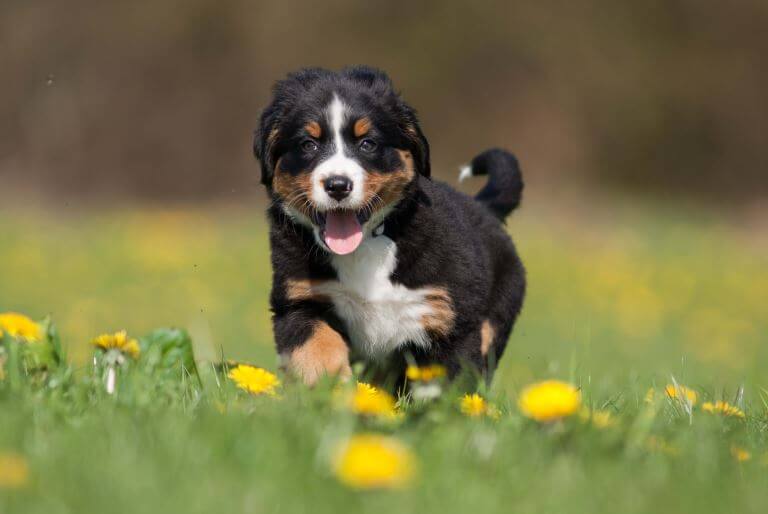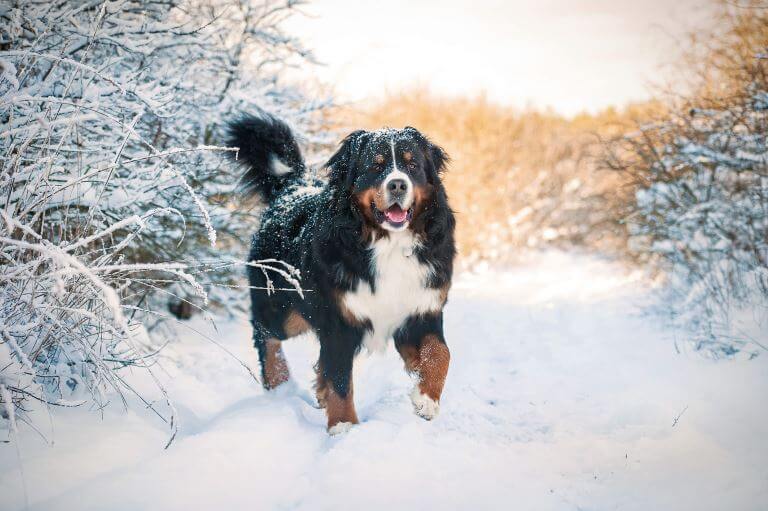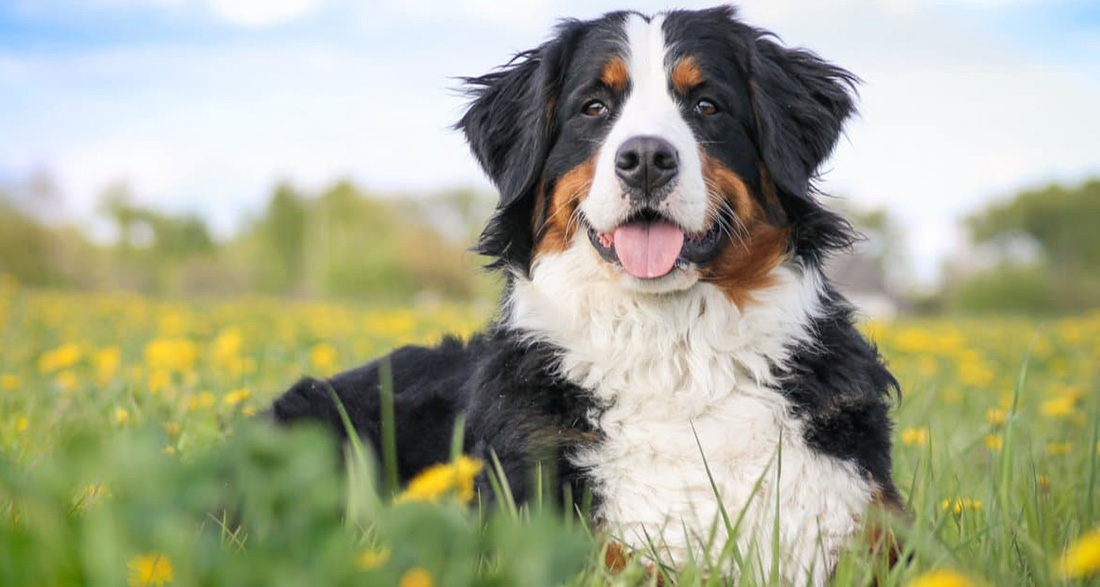The beautiful long coat, the gentle demeanor, and the friendly character make the Bernese Mountain Dog one of the most beloved family dogs in the world. Everything you need to know about the origin, temperament, and care of the breed can be found in this profile.
- History of the Bernese Mountain Dog
- Appearance of the Bernese Mountain Dog
- Temperament and Character
- Acquiring a Bernese Mountain Dog
- How to Care for a Bernese Mountain Dog?
- Development and Training of the Puppy
- How Much Exercise Does the Bernese Mountain Dog Need?
- Grooming a Bernese Mountain Dog
- Health and Hereditary Diseases
- Interesting and Worth Knowing
- Frequently Asked Questions
History of the Bernese Mountain Dog
The roots of the Bernese Mountain Dog go far back. It was once an indispensable companion to farmers in the Bern region (Switzerland), where it was used as a guard, draft, and herding dog. Its strength and endurance made it an indispensable helper on the farms. Particularly in the village of Dürrbach, this long-haired, tricolored farm dog was often encountered. Therefore, the locals affectionately called it “Dürrbächler.”
But the history of the Bernese Mountain Dog, or Bernese Sennenhund, really took off when in November 1907, some dog breeders joined forces and founded the “Swiss Dürrbach Club.” This was the beginning of a new era for the breed. It gained more and more popularity and was eventually officially renamed Bernese Mountain Dog on the advice of the geologist and cynologist Professor Dr. Heim. By the way, the name “Senn” is Swiss German and means Alpine herder. Fits quite well, don’t you think?
Today, the Bernese Mountain Dog is known and loved far beyond the borders of Switzerland. Its handsome appearance and amiable nature make it a popular family dog. Internationally, it is classified into the FCI Group 2 Section 3, Swiss Mountain and Cattle Dogs. The Bernese Mountain Dog was recognized as a breed by the AKC in 1937.
Breed Overview
GROUP: Working
HEIGHT: 23 to 26 inches (female), 25 to 27.5 inches (male)
WEIGHT: 70 to 95 pounds (female), 80 to 115 pounds (male)
COAT: Thick, medium-length double coat
COAT COLOR: Black, rust, and white or black, tan, and white
LIFE SPAN: 7 to 10 years
TEMPERAMENT: Gentle, even-tempered, loyal
HYPOALLERGENIC: No
ORIGIN: Switzerland
Appearance of the Bernese Mountain Dog
The Bernese Mountain Dog is undoubtedly an impressive sight. With its large and robust stature, it exudes an imposing presence. The males of this breed are characterized by an average shoulder height of 64-70 cm and a weight of about 40-44 kg. In comparison, females are slightly smaller, with a shoulder height of 58-66 cm and a weight of 32-40 kg.
Another notable feature of the Bernese Mountain Dog is its coat. It is dense, long, and shiny, which not only gives it an attractive appearance but also protects it from the cold temperatures in its homeland of Switzerland. The base color of the coat is black, complemented by brown and white markings in certain areas of the body. In particular, the paws are brown and white, creating an interesting contrast to the black base color.
The face of the Bernese Mountain Dog is characterized by a striking mask consisting of all three colors. This gives it a distinctive appearance and emphasizes its uniqueness among dog breeds. Depending on the individual, the coat can be smooth or slightly wavy, contributing to the diversity within the breed.
The tail of the Bernese Mountain Dog is bushy and seamlessly fits into the overall picture. It completes the magnificent appearance of this dog and adds an additional touch of majesty and dignity.
Temperament and Character
The Bernese Mountain Dog is a breed known for its friendly and gentle nature. Its loyalty to its family is remarkable, and it enjoys showing affection. These dogs are patient and loving, qualities that make them excellent family pets. Their amiable nature and compatibility with other pets are further advantages.
In the company of its family, the Bernese Mountain Dog feels most comfortable. It is a social dog that needs constant human contact. Its loyalty to its family is unwavering, and it is always eager to make its people happy.
Training a Bernese Mountain Dog is generally quite straightforward, provided there is enough consistency. They have hardly any hunting instinct and a low threshold for stimuli, making them pleasant companions.
Despite its size and strength, the Bernese Mountain Dog is not particularly well-suited as a guard dog. It never reacts aggressively to strangers and rather welcomes “intruders” with a cheerful wag of the tail. Its calm demeanor makes it a pleasant housemate who radiates peace and harmony rather than aggression.
Due to their intelligence and work ethic, Bernese Mountain Dogs are also popular as working dogs. They are trainable and adaptable, making them valuable helpers in various fields. Whether as a therapy dog, search and rescue dog, or simply as a loyal companion, the Bernese Mountain Dog is an asset in every role.
| Affection Level | High |
| Friendliness | High |
| Kid-Friendly | High |
| Pet-Friendly | High |
| Exercise Needs | Medium |
| Playfulness | Medium |
| Energy Level | Medium |
| Trainability | High |
| Intelligence | Medium |
| Tendency to Bark | Medium |
| Amount of Shedding | High |
Acquiring a Bernese Mountain Dog
If you are absolutely certain that you want to bring a Bernese Mountain Dog into your home, the first step is to find a reputable and registered breeder. Expect to pay prices starting from $1000 for a healthy puppy. However, you can also find Mountain Dogs or mixed breeds looking for new homes in animal shelters. These animals are usually very grateful and appreciate any form of affection. However, you must be cautious and find out if the dog’s history aligns with your abilities as a dog owner. Abused dogs may sometimes be emotionally scarred or traumatized and require special treatment.
How to Care for a Bernese Mountain Dog?
If you are considering getting a Bernese Mountain Dog puppy, you should be absolutely sure that the breed is suitable for you. After all, the dog, with a lifespan of up to 9 years, will be a part of your daily life for a long time. The first question you need to ask yourself is whether you have enough space for such a large dog. After all, the four-legged friend can weigh up to 50 kg and reach a height of up to 70 cm. An ideal scenario would be a large garden where the dog can frolic and keep watch. A small city apartment is absolutely unsuitable. Additionally, you should have enough time for the care and occupation of the large dog. A full-time office job often does not align well with the training and care of a large dog.

Development and Training of the Puppy
Due to its enormous size and strength, representatives of the Bernese Mountain Dog breed need consistent training from a young age, as the Bernese Mountain Dog can weigh up to 50kg and have a bite force of 556 PSI. What the young dog hasn’t learned in its early years is difficult to catch up on in adulthood. It’s best to take your puppy to a puppy school, where it can playfully learn the first commands and make contacts with other dogs. In the first few months, the small dog learns very quickly and should have many positive experiences. Typically, the training of this gentle breed goes smoothly, and you should not expect major setbacks. Occasionally, however, the puppy may react stubbornly if it doesn’t understand something or just isn’t in the mood. Despite their inherently good-natured character, you should remain consistent and always motivate the four-legged friend.
A major aspect of raising the puppy also lies in allowing the bones and joints to develop healthily. Do not overexert the young dog and do not let it climb stairs or romp around too much at the beginning. Then there’s a good chance that as an adult dog, despite its size, it will be less prone to joint problems.
How Much Exercise Does the Bernese Mountain Dog Need?
Although the Bernese Mountain Dog may appear clumsy and sluggish at first glance, it is very fond of running and requires exercise. You can make him very happy with regular walks in nature and small intelligence games. It is better not to use the large dog for active dog sports like agility, or only to a limited extent. He much prefers the work of a draft or rescue dog. Particularly in summer, you must be careful that the dog with its dense fur does not overheat and that you do not overstrain it. In snow and cold, on the other hand, the Bernese is at its absolute peak and is hardly stoppable.

Grooming a Bernese Mountain Dog
Just by looking at a Bernese Mountain Dog, you can immediately see that caring for the coat is very labor-intensive. As the owner of the four-legged friend, you should not have a problem with hair lying around in every imaginable place. You should brush the long fur at least two to three times a week and remove any stuck dirt and loose hairs. Especially during the shedding season in spring and autumn, the dog needs your attention and must be freed from the thick undercoat. Additionally, brushing promotes blood circulation and massages the skin. Most representatives of the breed enjoy the joint grooming session and strengthen the bond between human and dog. Unfortunately, Bernese Mountain Dogs have a lifespan of only about 7 to 10 years.
Health and Hereditary Diseases
One of the most common hereditary diseases in Bernese Mountain Dogs is hip dysplasia. This is a condition where the hip joints are not properly developed and can lead to pain and inflammation. Also, attention should be paid to the hereditary disease progressive retinal atrophy (PRA). It is a degenerative eye disease that can lead to blindness.
It is also important to monitor Bernese Mountain Dogs regularly for gastric dilatation-volvulus (GDV). This condition occurs when the dog’s stomach twists, blocking blood flow to the stomach. This can lead to serious complications and is often life-threatening. Therefore, when choosing a breeder, make sure that they only breed dogs free from these hereditary diseases to reduce the spread.
To ensure that Bernese Mountain Dogs stay healthy, it is important to take them to the veterinarian regularly and watch for signs of illness and discomfort. A balanced diet, regular exercise, and adequate rest can also help maintain the health of Bernese Mountain Dogs.
Due to many breed-specific diseases and other problems resulting from inbreeding, representatives of this breed tend to die relatively young. Nevertheless, there are some exceptions, such as the Bernese Mountain Dog named Penny from Ostallgäu, who lived to be a proud 25 years old.
Interesting and Worth Knowing
The good-natured Sennenhund is also a very popular pet outside of its home country. Even celebrities from overseas, such as the singer Hilary Duff or the actress Kate Hudson, have taken a liking to these four-legged companions with their loyal gaze. In the Alpine region, the breed is naturally still particularly popular. For example, the male dog Quincey from Wiesmadern appears in several music videos of the Austrian schlager star Hansi Hinterseer. Additionally, the actor Christian Tramitz as well as the schlager singer Andrea Berg have a Bernese at home. Among children, the breed is popular not least because of its appearance in the show “Löwenzahn.” Here, a Bernese Mountain Dog named Keks lives with his owner Fritz Fuchs in the old caravan in Bärstadt and experiences new exciting adventures.
Similar and Related Breeds:
As the name promises, the Bernese Mountain Dog belongs to the Sennenhunds. If you like the Bernese Mountain Dog but it’s too large, perhaps the Appenzeller Sennenhund or the Entlebucher Sennenhund is just right for you. Likewise, the Greater Swiss Mountain Dog belongs to this family. This one can grow even larger than the Bernese, weighing up to 64 kg. Also significantly larger is the Saint Bernard, which is often mistaken for the Bernese Mountain Dog. Bernese Mountain Dogs are also often crossed with other breeds. A particularly popular hybrid dog is the Bernerdoodle.
Bernese Mountain Dog Overview
Pros
- Excellent family pet
- Loyal, devoted
- Energetic but not exhausting
- Trainable
Cons
- Short life span
- Heavy shedding
- Some drool
- Heavy coat isn’t good for warm climates
- Best to have access to a yard
Do you also have a Bernese Mountain Dog or are you planning to get one soon? Tell me in the comments what makes the Bernese so special!
Frequently Asked Questions
Are Bernese Mountain Dogs kid-friendly?
Yes, Bernese Mountain Dogs are generally kid-friendly and patient with children. They can be great playmates.
Do Bernese Mountain Dogs need a lot of exercise?
Yes, Bernese Mountain Dogs require regular exercise to stay fit and healthy. Long walks and active playtimes are important for their well-being.
Are Bernese Mountain Dogs easy to train?
Berner Sennenhunds are intelligent and eager to learn, which makes training easier. However, consistent and positive training is important to achieve good results.
How long does a Bernese Mountain Dog live?
The average lifespan of a Bernese Mountain Dog is between 7 and 10 years. Good care and a healthy lifestyle can help extend their lifespan.
Are Bernese Mountain Dogs suitable for apartments?
Due to their size and exercise needs, Bernese Mountain Dogs are better suited for houses with a fenced yard. They require ample space to move around freely.


